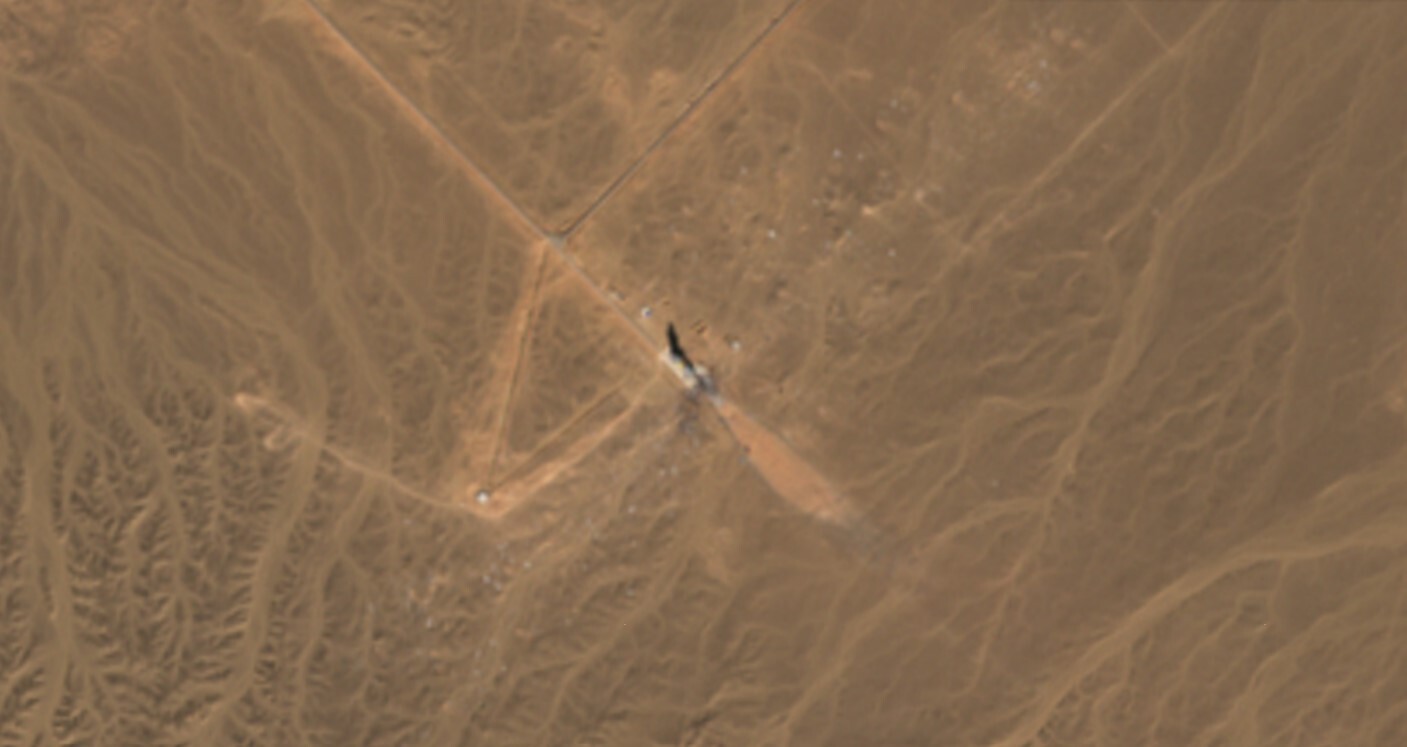30.11.2023

ESA Sentinel-2 satellite imagery from Nov. 26, 2023, showing the aftermath of an apparent explosion at Jiuquan Satellite Launch Center in the Gobi Desert. Credit: Sentinel Hub EO Browser/CC BY 4.0
HELSINKI — A Chinese launch vehicle maker appears to have suffered an explosion at a test site at Jiuquan Satellite Launch Center.
Satellite images show what are likely test stand facilities and the apparent aftermath of an exhaust plume from a hot fire test on the desert surface. Charred debris can be seen scattered across the surrounding area.
The images were published by Harry Stranger, who uses satellite imagery to track space industry developments, on X, the social media platform formerly known as Twitter.
Stranger highlights a number of before and after images, using Planet optical, ESA Sentinel and Umbra radar imagery. The images help constrain the date of the explosion to between 0416 UTC, Nov. 21, and 0321, Nov. 22. An explosion occurred at the same facilities in October 2021.
The facilities are believed to be operated by the China Aerospace Science and Industry Corp. (CASIC), a giant state-owned enterprise engaged in defense and space, and developer of Kuaizhou solid rockets. The infrastructure appears to resemble that setup at Jiuquan by a CASIC subsidiary.
The explosion is far from Jiuquan’s launch infrastructure and is unlikely to impact other launch-related activity at the site. CASIC meanwhile uses transport erector launchers for its rockets.
CASIC, through its subsidiary Expace, operates a pair of solid rockets known as Kuaizhou-1A and the larger Kuaizhou-11. Neither entity has made an announcement on the explosion and it is unclear how the event will impact one or both of the launchers. Expace stated it held product quality reviews and related visits in recent days.
The Kuaizhou-1A is capable of carrying 200 kilograms of payload into a 700-kilometer sun-synchronous orbit (SSO). The larger Kuaizhou-11 can carry 1,000 kilograms to a 700-kilometer SSO. That latter has flown only twice. The first, in July 2020, ended in failure. The second, in December 2022, was successful.
It has launched 24 Kuaizhou-1A and 11 rockets since 2017, suffering three failures. Flights of both the Kuaizhou-1A and -11 were expected in the fourth quarter of the year. It is unclear whether or not these launches will yet take place before the end of the year.
Jiuquan Satellite Launch Center is a sprawling site in the Gobi Desert. It was established in 1958 as was the first of China’s four national spaceports to be constructed. It hosts regular orbital satellite launches as well as China’s human spaceflight mission. These are conducted using older hypergolic Long March rockets.
Jiuquan has however undergone an expansion in recent years. This has come in response to a surge in space launch actors seeking access to facilities and meeting a growth in demand for launch.
This includes solid rockets for commercial launchers using transport erector launchers, such as Kuaizhou rockets. New facilities were built by Landspace to support the launch of its Zhuque-2, a methane-liquid oxygen rocket. Tianlong-2, a kerosene-liquid oxygen launcher, had its first ever launch at Jiuquan earlier this year.
CASIC and its Expace subsidiary would appear to be facing numerous challenges. It is one of the best-funded commercial launch companies in China, raising $180 million in 2017 and $237 million last year. Its efforts fit within a wider strategic effort to develop solid launchers to boost China’s overall space capabilities.
Chinese startups are however undermining the company’s progress. Galactic Energy, established in 2018, has conducted 10 orbital launches of its Ceres-1 rocket, with the latest being the only failure. Ceres-1 can lift 300 kg of payload to a 500-km-altitude SSO and has demonstrated a big increase in launch cadence in 2023. The company is set to attempt a return to flight and is working on the kerolox Pallas-1 rocket.
Meanwhile, one of China’s most recently-established startups, Orienspace, is preparing to launch a much larger solid rocket than any operational Kuaizhou rocket. The Gravity-1 is expected to launch from a sea platform in December. The rocket has three solid stages and four side boosters. The rocket will have the capability to lift around 6,500 kilograms to LEO, or 3,700 kilograms to 700-km SSO.
CASIC also faces more traditional competitors. CAS Space, also referred to as Zhongke Aerospace, is a commercial spinoff from the Chinese Academy of Sciences (CAS), similar to Expace and its relationship with CASIC. The firm has begun launching its Lijian-1/Kinetica-1 solid rocket, which is similar in capacity to the Kuaizhou-11.
The launcher temporarily set a Chinese record for the most satellites on a single launch in June this year. CASC, China’s main space contractor, operates the new Jielong-3 solid rocket which can launch on a sea platform.
A successful launch would put additional pressure on Expace. Kuaizhou rockets are however expected to launch an 80-satellite narrowband constellation named Xingyun.CASIC and Expace had presented plans in recent years for larger Kuaizhou-21 and -31 solid rockets which would be capable of carrying 20 and 70 tons to LEO respectively.
It has however more recently announced work on methalox engines, suggesting a pivot to liquid launchers and potential reusability.
Quelle: SN

